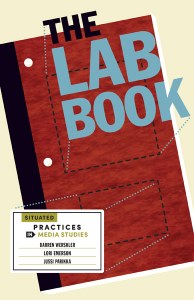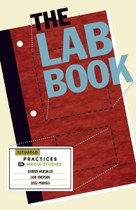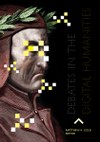The Lab Book
Situated Practices in Media Studies
Darren Wershler, Lori Emerson, and Jussi Parikka

READ FREE ONLINE: MANIFOLD EDITION
An important new approach to the study of laboratories, presenting a practical method for understanding labs in all walks of life
Organized by interpretive categories such as space, infrastructure, and imaginaries, The Lab Book uses historical and contemporary examples of how laboratories are fundamentally connected to changes in the contemporary university. The authors cover topics such as the evolution and delineation of lab-based communities, how labs’ tools and technologies contribute to defining their space, and a glossary of key hybrid lab techniques.
"Lively, timely, and filled with vivid examples, The Lab Book is a highly readable and critically sophisticated account of current lab culture. Written by three distinguished practitioners, it examines the rhetoric that links real and imaginary ideas of experimentality with systems of power and authority across a surprising range of disciplines. A fun, smart, useful guide to ongoing work in media studies."
—Johanna Drucker, author of Visualization and Interpretation: Humanistic Approaches to Display
From the “Big Science” of Bell Laboratories to the esoteric world of séance chambers to university media labs to neighborhood makerspaces, places we call “labs” are everywhere—but how exactly do we account for the wide variety of ways that they produce knowledge? More than imitations of science and engineering labs, many contemporary labs are hybrid forms that require a new methodological and theoretical toolkit to describe. The Lab Book investigates these vital, creative spaces, presenting readers with the concept of the “hybrid lab” and offering an extended—and rare—critical investigation of how labs have proliferated throughout culture.
Organized by interpretive categories such as space, infrastructure, and imaginaries, The Lab Book uses both historical and contemporary examples to show how laboratories have become fundamentally connected to changes in the contemporary university. Its wide reach includes institutions like the MIT Media Lab, the Tuskegee Institute’s Jesup Wagon, ACTLab, and the Media Archaeological Fundus. The authors cover topics such as the evolution and delineation of lab-based communities, how labs’ tools and technologies contribute to defining their space, and a glossary of key hybrid lab techniques.
Providing rich historical breadth and depth, The Lab Book brings into focus a critical, but often misunderstood, aspect of the contemporary arts and humanities.
$30.00 paper ISBN 978-1-5179-0218-6
$120.00 cloth ISBN 978-1-5179-0217-9
328 pages, 41 b&w photos, 5 1/2 x 8 1/2, March 2022

Darren Wershler is Concordia University Research Chair in media and contemporary literature, cofounder of the Media History Research Centre, and director of the Residual Media Depot in the Milieux Institute at Concordia University in Montreal. Wershler’s other books include Guy Maddin’s My Winnipeg; The Iron Whim: A Fragmented History of Typewriting; and FREE as in Speech and Beer: Open Source, Peer-to-Peer, and the Economics of the Online Revolution.
Lori Emerson is associate professor in the Department of English and director of the Intermedia Arts, Writing, and Performance Program at the University of Colorado at Boulder. She is founding director of the Media Archaeology Lab and author of Reading Writing Interfaces: From the Digital to the Bookbound (Minnesota, 2014).
Jussi Parikka is professor of digital aesthetics and culture at Aarhus University as well as professor at University of Southampton and visiting professor at FAMU, Prague. He is author of A Geology of Media, Insect Media (both from Minnesota), Digital Contagions, and What Is Media Archaeology?

Lively, timely, and filled with vivid examples, The Lab Book is a highly readable and critically sophisticated account of current lab culture. Written by three distinguished practitioners, it examines the rhetoric that links real and imaginary ideas of experimentality with systems of power and authority across a surprising range of disciplines. A fun, smart, useful guide to ongoing work in media studies.
Johanna Drucker, author of Visualization and Interpretation: Humanistic Approaches to Display
The Lab Book makes an extremely important contribution to contemporary discourse about the production of knowledge. In many ways, it is the most important book on the topic since the laboratory studies of Bruno Latour in its potential reach across disciplines and methodologies. Its careful close reading of images and quoted material is particularly compelling, and the writing style is accessible and clear, even while explaining somewhat arcane topics in science studies around infrastructures, apparatuses, ideologies, and assemblages.
Elizabeth Losh, author of Hashtag
The Lab Book is a crucial intervention into humanities labs and their precarious institutional environments. Situated between science and technology studies (STS) and media archaeology, Wershler, Emerson, and Parikka’s book develops a heuristic for analyzing these hybrid spaces, producing a valuable tool for understanding the assemblages of space, apparatus, infrastructure, people, and imaginaries supporting their existence.
Theory, Culture & Society

Contents
Acknowledgments
Introduction: Everything Is a Lab
Case Study: The French Language Lab (Middlebury College, U.S.)
1. Lab Space
Case Study: Menlo Park Laboratory (Menlo Park, U.S.)
Case Study: MIT Media Lab, Part 1 (MIT, U.S.)
Case Study: Media Archaeological Fundus (Humboldt University, Germany)
2. Lab Apparatus
Case Study: The Signal Laboratory (Humboldt University, Germany)
Case Study: The Media Archaeology Lab (University of Colorado Boulder, U.S.)
3. Lab Infrastructure
Case Study: Home Economics Labs and Extension on the Canadian Prairies (Manitoba, Canada)
Case Study: Black Laboratories and Agricultural Extension
4. Lab People
Case Study: MIT Media Lab, Part 2 (MIT, U.S.)
Case Study: ActLab (University of Texas Austin, U.S.)
5. Lab Imaginaries
Case Study: Hybrid Spaces of Experimentation and Parapsychology
Case Study: Bell Labs, A Factory for Ideas
6. Lab Techniques
Conclusion
Notes
Bibliography
Index













